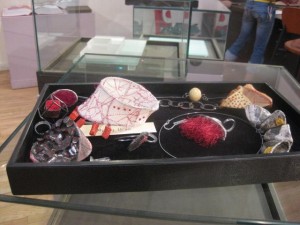
Paper, Rock, Scissors: The Shape of New Design
PAPER
Last month I encountered Myung Ursos work at Patina Gallery. A Korean artist, her work incorporates paper, particularly mulberry paper, cocoon silk, the rare weft of sponge. She has the habit of making what appear to be pockets in jewelry to be worn, so that a section that folds, so as to lie flat against the skin, again encloses. Pockets a little riffle of another thing, an anemone-like cluster of red thread; or a form of geometry, call it a cube worn off the finger, nests another small moving part. Ever since Kiff Slemmons did paper jewelry on a huge scale I have been fascinated with the concept so risky in a rainstorm. Such is not the case with Ursos. It is small and seems sturdy although sewn.

Myung Urso designs at Patina Gallery in Santa Fe
Maybe because I think so much about paper, as a former print editor turned new media person (electrons, baby), her work reassures me how okay it is (very OK) to be still in love with objects. Especially when objects are done so perfectly, use material with such rightness in the choice and application, that they deliver a sense of optimism, as if everything wrong with the world can be made suddenly right. Of course, also, that is fashion, and like food, the organism dies without it. (Well, maybe not fashion per se, but shelter from the storm, indeed.) It makes me doubly happy to learn in the artists statement that she has found inspiration for her jewelry in things such as her elderly mothers shaping of the ricecake. For there is nourishment in great fashion and this ones use of paper makes it affordable, indeed entry level, for a jeweler artisan who is destined to do great things.
ROCK
Well, okay, clay, if you have to be literal about it. Porcelain. Yet sculpture of such thinness that communicates bedrock strength, so that one could point and say, “rock,” meaning also, foundational to modernism and the way clay, Ruth Duckworths use of clay, changed things.

Ruth Duckworth
Ruth Duckworth died last October age 90. Her work which totally changed the practice of clay during seminal decades of last century came with a political history many likely do not know: she defaced a Nazi monument in Germany as a young girl where, because her father was Jewish, she was not permitted to attend school. She carved puppet heads early in her life. She engraved gravestones, was mentored by Lucie Rie, and finally went to live in Chicago in the 1960s, where she made her work breakthroughs and continued to have her studio, where she lived and worked throughout her life. Interesting if you construe how Beatrice Wood and Ruth Duckworth, artists of clay, both broke through the limitations of making goods for the table. And both lived to be old enough to have actually experienced their work properly construed as art. When I first saw a lot of work by Duckworth all together, it was so thrilling for me who had been tabletop editor of HFD and had seen, of course, Woods work, but not Duckworths. That has to have been 12 or 13 years ago at Santa Fes Bellas Artes Gallery where owners Bob and Charlotte Kornstein worked with the artist, and installed her work using their brilliant eye(s), near festooned works on paper by Judy Pfaff, inside cases where other rows might be filled with small pre-Columbian statue.
As I think back of leaning in to see Duckworths small power objects, I can still recall the charge, as of depth compression or of something so massively energetic, embodied in indeed very small forms usually not more than 4 or 6 inches high. She had been influenced by Henry Moore and had worked in mural scales such as the 400-square-foot Earth Water Sky mural at University of Chicago (1968). Interestingly and maybe tellingly as if of prescience, the flat bird silhouettes detaching from the surface of the mural she completed before her death remind of the integral problem in sculpture: the detachment of form from its structure, sculpture as relief object, and so it strikes me as so interesting that she was up to that at the end.
I talked to Ruth Duckworth one summer day in the Bellas Artes courtyard where one of her monumental pieces is installed. She was tiny and birdlike herself, with a piercing black gaze and eyebrows. Hand on her cane, she wore a beautiful fabric and sensible shoes and looked about, at her ease.
SCISSORS
Rex Ray collages on linen have the characteristic of worlds scissored out so flat that they communicate adeptly that the veil really is blade-thin. If one were to get all art historically puffy about it youd say they contend with 2 dimensionality being abridged, wanting to turn into a sort of carnival on a river boat such as Miss Kitty or Blanche DuBois might go tripping about in search of a kind stranger. At MCA Denver last year I saw a Rex Ray mural and it was, as I think of it now, an interesting experience to have in one of the spaces of the museum that architect David Adjaye has said he wished to communicate, architecturally, as “sidewalk,” urban space in public among the more private “village” spaces of how he construed the galleries. These are all interesting ideas in new art and it so behooves us all to look at things deeply and inquire which conversations they are starting and why. Rex Ray at Turner Carroll Gallery opens July 9.

